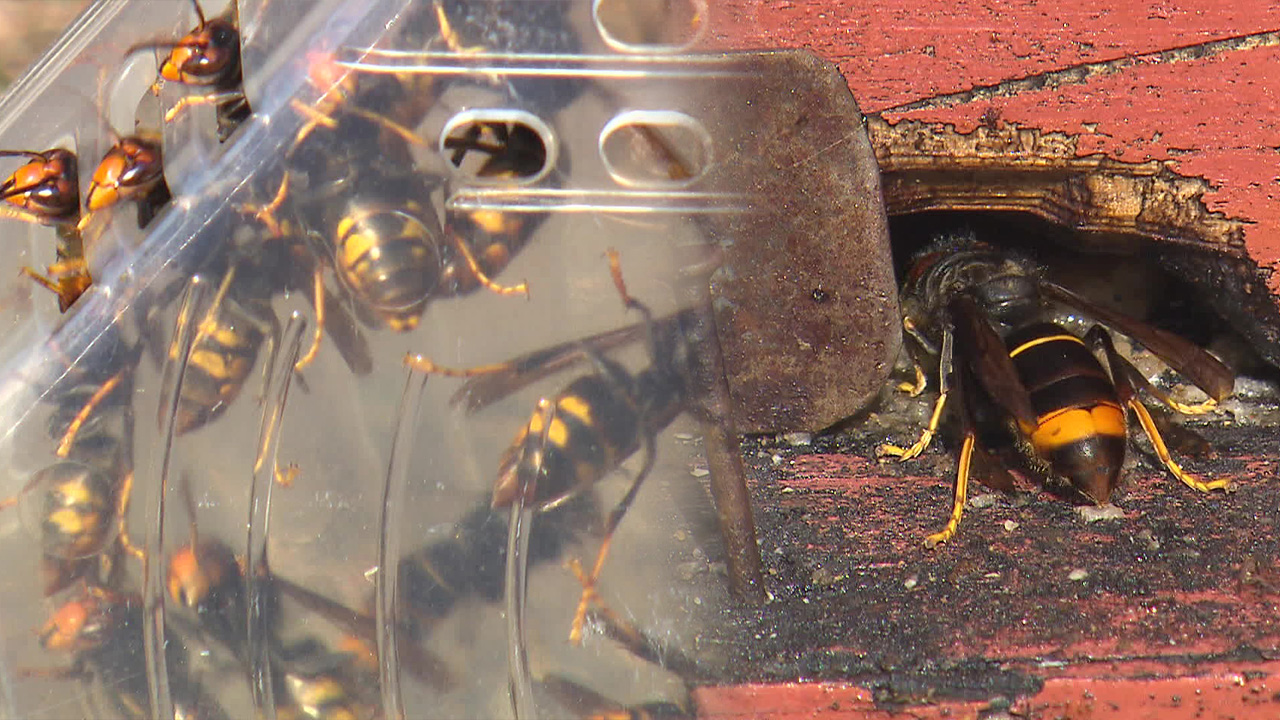[Anchor]
The concerns of beekeepers do not end there.
That's because of the Asian giant hornet, which voraciously preys on honeybees.
They are making their appearances earlier, and their habitat area is rapidly increasing.
Shin Bang-sil reports.
[Report]
Honeybees busily gather nectar while flitting between spring flowers and beehives.
The beekeepers are also busy caring for the bees.
From now until the harvest of acacia honey in May and June is the most crucial period out of the annual farming cycle, but worries are mounting.
This is because the Asian giant hornets that prey on honeybees are waking up.
[Joo Kwang-kyu/Beekeeper: "The hornets that have just awakened from hibernation are coming. Even if we catch them all, we don't know where they keep coming from. We're almost given up..."]
Originally native to subtropical regions, the first inflow of the Asian giant hornet in Korea was in 2003.
With climate change leading to warmer winters, they have been able to survive in Korea and are now spread across the country, except for Jeju and Ulleungdo.
In 2019, they were designated as an invasive species, and their aggressive nature poses a threat to humans as well.
Recently, due to milder winters, the emergence of queen hornets has been occurring 0.2 days earlier each year, and their habitat area has been increasing by 0.5%.
[Jo Yu-ri/Senior Researcher, Seoul National University Environmental Planning Institute: "The queen hornets are making their appearance much earlier, which means that we can draw the conclusion that worker bees are also emerging earlier."]
Experts advise that since the Asian giant hornet has few natural enemies, efforts for pest control should be concentrated during the time when the queen hornets appear.
This is KBS News, Shin Bang-sil.
The concerns of beekeepers do not end there.
That's because of the Asian giant hornet, which voraciously preys on honeybees.
They are making their appearances earlier, and their habitat area is rapidly increasing.
Shin Bang-sil reports.
[Report]
Honeybees busily gather nectar while flitting between spring flowers and beehives.
The beekeepers are also busy caring for the bees.
From now until the harvest of acacia honey in May and June is the most crucial period out of the annual farming cycle, but worries are mounting.
This is because the Asian giant hornets that prey on honeybees are waking up.
[Joo Kwang-kyu/Beekeeper: "The hornets that have just awakened from hibernation are coming. Even if we catch them all, we don't know where they keep coming from. We're almost given up..."]
Originally native to subtropical regions, the first inflow of the Asian giant hornet in Korea was in 2003.
With climate change leading to warmer winters, they have been able to survive in Korea and are now spread across the country, except for Jeju and Ulleungdo.
In 2019, they were designated as an invasive species, and their aggressive nature poses a threat to humans as well.
Recently, due to milder winters, the emergence of queen hornets has been occurring 0.2 days earlier each year, and their habitat area has been increasing by 0.5%.
[Jo Yu-ri/Senior Researcher, Seoul National University Environmental Planning Institute: "The queen hornets are making their appearance much earlier, which means that we can draw the conclusion that worker bees are also emerging earlier."]
Experts advise that since the Asian giant hornet has few natural enemies, efforts for pest control should be concentrated during the time when the queen hornets appear.
This is KBS News, Shin Bang-sil.
■ 제보하기
▷ 카카오톡 : 'KBS제보' 검색, 채널 추가
▷ 전화 : 02-781-1234, 4444
▷ 이메일 : kbs1234@kbs.co.kr
▷ 유튜브, 네이버, 카카오에서도 KBS뉴스를 구독해주세요!
- Threat of Asian giant hornets
-
- 입력 2025-05-05 05:18:03

[Anchor]
The concerns of beekeepers do not end there.
That's because of the Asian giant hornet, which voraciously preys on honeybees.
They are making their appearances earlier, and their habitat area is rapidly increasing.
Shin Bang-sil reports.
[Report]
Honeybees busily gather nectar while flitting between spring flowers and beehives.
The beekeepers are also busy caring for the bees.
From now until the harvest of acacia honey in May and June is the most crucial period out of the annual farming cycle, but worries are mounting.
This is because the Asian giant hornets that prey on honeybees are waking up.
[Joo Kwang-kyu/Beekeeper: "The hornets that have just awakened from hibernation are coming. Even if we catch them all, we don't know where they keep coming from. We're almost given up..."]
Originally native to subtropical regions, the first inflow of the Asian giant hornet in Korea was in 2003.
With climate change leading to warmer winters, they have been able to survive in Korea and are now spread across the country, except for Jeju and Ulleungdo.
In 2019, they were designated as an invasive species, and their aggressive nature poses a threat to humans as well.
Recently, due to milder winters, the emergence of queen hornets has been occurring 0.2 days earlier each year, and their habitat area has been increasing by 0.5%.
[Jo Yu-ri/Senior Researcher, Seoul National University Environmental Planning Institute: "The queen hornets are making their appearance much earlier, which means that we can draw the conclusion that worker bees are also emerging earlier."]
Experts advise that since the Asian giant hornet has few natural enemies, efforts for pest control should be concentrated during the time when the queen hornets appear.
This is KBS News, Shin Bang-sil.
The concerns of beekeepers do not end there.
That's because of the Asian giant hornet, which voraciously preys on honeybees.
They are making their appearances earlier, and their habitat area is rapidly increasing.
Shin Bang-sil reports.
[Report]
Honeybees busily gather nectar while flitting between spring flowers and beehives.
The beekeepers are also busy caring for the bees.
From now until the harvest of acacia honey in May and June is the most crucial period out of the annual farming cycle, but worries are mounting.
This is because the Asian giant hornets that prey on honeybees are waking up.
[Joo Kwang-kyu/Beekeeper: "The hornets that have just awakened from hibernation are coming. Even if we catch them all, we don't know where they keep coming from. We're almost given up..."]
Originally native to subtropical regions, the first inflow of the Asian giant hornet in Korea was in 2003.
With climate change leading to warmer winters, they have been able to survive in Korea and are now spread across the country, except for Jeju and Ulleungdo.
In 2019, they were designated as an invasive species, and their aggressive nature poses a threat to humans as well.
Recently, due to milder winters, the emergence of queen hornets has been occurring 0.2 days earlier each year, and their habitat area has been increasing by 0.5%.
[Jo Yu-ri/Senior Researcher, Seoul National University Environmental Planning Institute: "The queen hornets are making their appearance much earlier, which means that we can draw the conclusion that worker bees are also emerging earlier."]
Experts advise that since the Asian giant hornet has few natural enemies, efforts for pest control should be concentrated during the time when the queen hornets appear.
This is KBS News, Shin Bang-sil.
-
-

신방실 기자 weezer@kbs.co.kr
신방실 기자의 기사 모음
-
이 기사가 좋으셨다면
-
좋아요
0
-
응원해요
0
-
후속 원해요
0















이 기사에 대한 의견을 남겨주세요.